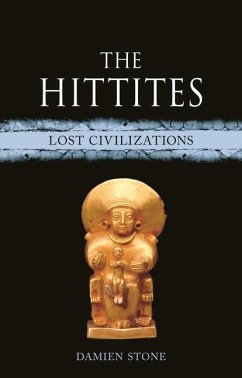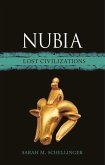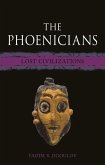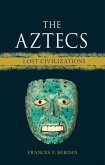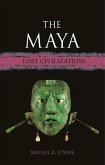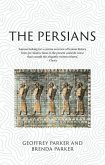19,99 €
inkl. MwSt.
Versandfertig in über 4 Wochen

10 °P sammeln
- Gebundenes Buch
- Merkliste
- Auf die Merkliste
- Bewerten Bewerten
- Teilen
- Produkt teilen
- Produkterinnerung
- Produkterinnerung
A fine introduction to the culture and art of the Hittites, a vibrant civilization that flourished in central Anatolia from the 17th to the 13th century BC.
Andere Kunden interessierten sich auch für
![Nubia Nubia]() Sarah SchellingerNubia19,99 €
Sarah SchellingerNubia19,99 €![The Etruscans The Etruscans]() Lucy ShipleyThe Etruscans14,99 €
Lucy ShipleyThe Etruscans14,99 €![Egypt Egypt]() Christina RiggsEgypt14,99 €
Christina RiggsEgypt14,99 €![The Phoenicians The Phoenicians]() Vadim S. JigoulovThe Phoenicians19,99 €
Vadim S. JigoulovThe Phoenicians19,99 €![The Aztecs The Aztecs]() Frances F. BerdanThe Aztecs19,99 €
Frances F. BerdanThe Aztecs19,99 €![The Maya The Maya]() Megan E. O'NeilThe Maya19,99 €
Megan E. O'NeilThe Maya19,99 €![The Persians The Persians]() Brenda ParkerThe Persians14,99 €
Brenda ParkerThe Persians14,99 €-
-
-
A fine introduction to the culture and art of the Hittites, a vibrant civilization that flourished in central Anatolia from the 17th to the 13th century BC.
Produktdetails
- Produktdetails
- Lost Civilizations
- Verlag: Reaktion Books
- Seitenzahl: 192
- Erscheinungstermin: 1. Februar 2023
- Englisch
- Abmessung: 220mm x 142mm x 20mm
- Gewicht: 498g
- ISBN-13: 9781789146844
- ISBN-10: 1789146844
- Artikelnr.: 66121547
- Lost Civilizations
- Verlag: Reaktion Books
- Seitenzahl: 192
- Erscheinungstermin: 1. Februar 2023
- Englisch
- Abmessung: 220mm x 142mm x 20mm
- Gewicht: 498g
- ISBN-13: 9781789146844
- ISBN-10: 1789146844
- Artikelnr.: 66121547
Damien Stone is an archaeologist based at Chau Chak Wing Museum, Sydney, Australia. He is the author of Pomegranate: A Global History, also published by Reaktion Books. The seventeenth century BC saw a dynasty of kings emerge speaking an Indo-European language in what is now central Turkey. Their culture was a quirky combination of established ancient Near Eastern practices blended with native Anatolian customs. As their empire expanded, until its fall at the start of the twelfth century BC, it continued to absorb traditions from conquered peoples. Recognized for their military prowess among the contemporary civilizations of the Bronze Age, they are now known as the Hittites. This book aims to give an overview of the Hittites and their customs, in the hope of increasing the recognition and renown that these often-overlooked ancient people deserve. The term 'Anatolia' is commonly used as the name for the homeland of the Hittites, the highland plateau region of modern Turkey. It is of Greek origin, first used much later (in the tenth century ad), deriving from anatole meaning 'rising'- as the Greeks looked east, it was from Anatolia that the Sun rose. The Hittites themselves referred to their homeland simply as the land of Hatti. This designation is not to be confused with the Hattians, fore-runners in the region prior to the arrival of the Hittites - several unique cultures had already developed in this area prior to the emergence of the Hittite society. Likewise, the Hittites would not be the last - from the Phrygians and Graeco-Romans to the Seljuks and Ottomans, this area would remain prime real estate. The high-altitude Anatolian plateau where Hittites dwelled faced climatic extremes, alternating hot, dry summers and cold, snowy winters. Surrounded by mountains, during the Bronze Age this semi-arid area was thickly forested. The Pontic mountain range lies to the north of the plateau, while the Taurus Mountains border the south. To the west lies a fertile river valley. Rivers give rise to great civilizations, and for the Hittites theirs was the Marassantiya. In the classical era it was called the Halys River, and today it is known by the modern Turkish name of the Kızılırmak (Red River). However, it was rainfall rather than irrigation that offered the main supply of water in this region, on which the Hittite agrarian-based economy depended. Springs also played an important role as a water source for the Hittites, the capital of Hattusa being supplied by seven springs. The borders of the Hittite state were constantly shifting but reached their furthest extent at the end of the fourteenth century BC. Territory outside of the Hittite homeland in central Anatolia was controlled not directly but through vassalage. The Hittites were not a seafaring people, as their central homeland was landlocked. On the seldom occasion that they engaged in naval enterprises, they relied on the ships of their allies or vassal states. Hittite society was divided into three main spheres: the religious, the agricultural and the martial. At the head of society was the Hittite king, who oversaw the success of each sphere. All depended on a monarch's ability to maintain order, particularly by preserving relations with the heavenly gods. Offending the gods could result in plague, famine, invasion, military failure and civil strife, all of which were regarded as forms of divine retribution. A team of his most trusted officials assisted the king in maintaining this balance, which kept society operating. The two major sources of economic revenue were agriculture and the booty (as well as the subsequent tribute) brought back from subjugating neighbouring states. The vast majority of people lived outside cities in farming villages. Further archaeological work and study remains to be done to comprehend the experience of these lower classes. Our understanding of Hittite society is still highly skewed towards the exploits of royalty, whose bureaucracy produced the majority of Hittite texts. Nonetheless, these documents are rich resources, and I have quoted from them extensively throughout this book, allowing those ancient voices to speak to the modern reader. Hittite history is marked by two periods of influence. Using the Middle Chronology for dating the ancient Near East, the Hittite Old Kingdom refers to the era from the mid-seventeenth century BC to the end of the fifteenth century BC. The Hittite New Kingdom began with the reign of King Tudhaliya i/ii in circa 1400 BC and concluded with the collapse of the empire around 1200 BC. But before we journey back to the Bronze Age, we must begin our exploration with some more recent events, as two hundred years ago, the Hittites were largely unknown beyond the scattered references to people by this name in the Bible.
